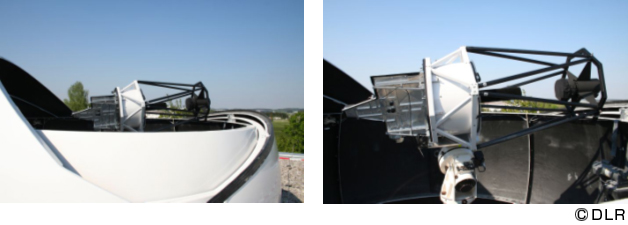Success with Optical Communication Experiment between the Optical Inter-orbit Communication Engineering Test Satellite "Kirari" (OICETS) and the Optical Ground Station at German Aerospace Center (DLR)
Japan Aerospace Exploration Agency (JAXA)
The Japan Aerospace Exploration Agency (JAXA) successfully carried out an optical communication experiment using laser beams between its Optical Inter-orbit Communication Engineering Test Satellite "Kirari" (OICETS), at an altitude of about 600 km, and the optical ground station "OGS-OP" (Optical Ground Station Oberpfaffenhofen) of the German Aerospace Center (Deutsche Forschungsanstalt fur Luft- und Raumfahrt, DLR, in Wessling, Bayern) at 10:13 a.m. on June 7, 2006 (Japan Standard Time, JST). JAXA and DLR confirmed that optical communication (downlink from the "Kirari") was successfully performed for 3 minutes.
The "Kirari" has already performed a bi-directional optical communication experiment successfully with the optical ground station of the National Institute of Information and Communication Technology (NICT) last March. However, the DLR optical ground station is unique as it is a mobile station. Therefore, the success this time indicates the possibility of establishing a flexible optical communication network with a satellite and a mobile optical ground station.
The "Kirari" is scheduled to continue experiments including an optical communication test with an optical ground station and an inter-orbit optical communication test with the Advanced Relay and Technology Mission (ARTEMIS) of the European Space Agency (ESA) to acquire statistical data.
|
|
[Supplementary Information: Outline of the DRL Optical Ground Station]
Location: Institute of Communication and Navigation, German Aerospace Center, Wessling, Bayern, Germany
Optical system: Cassegrainian Reflecting Telescope (Diameter: 40cm)
Transmitted Laser beam: Output: about 10W Beam Divergence Angle: 5 milliradian
Optical communication receiving element: Avalanche photo diode*1
*1 When electrons are generated by an optical signal in a semiconductor to which an electric field is applied, electrons are accelerated by the electric field and gain large energy. When these electrons collide with atoms in the semiconductor crystals, more electrons are pushed out from the atoms. These newly generated electrons are also accelerated by the electric field and collide with atoms to push out more electrons. This phenomenon causes a so-called "electron avalanche," or a chain reaction of increasing the number of electrons. This phenomenon leads to another phenomenon called "avalanche duplation." The avalanche photo diode is a photo diode with extremely high sensitivity that uses these phenomena. It is mainly used as a receiver for optical signals.
<DLR Optical Ground Station>

(Reference: NICT optical ground station)
Location: Koganei city, Tokyo
Optical system: Cassegrain reflecting telescope (Diameter 1.5 m)
Optical communication receiving element: Avalanche photo diode
For inquiries:
JAXA Public Affairs Department
Tel: +81-3-6266-6413 to 7, Fax: +81-3-6266-6910